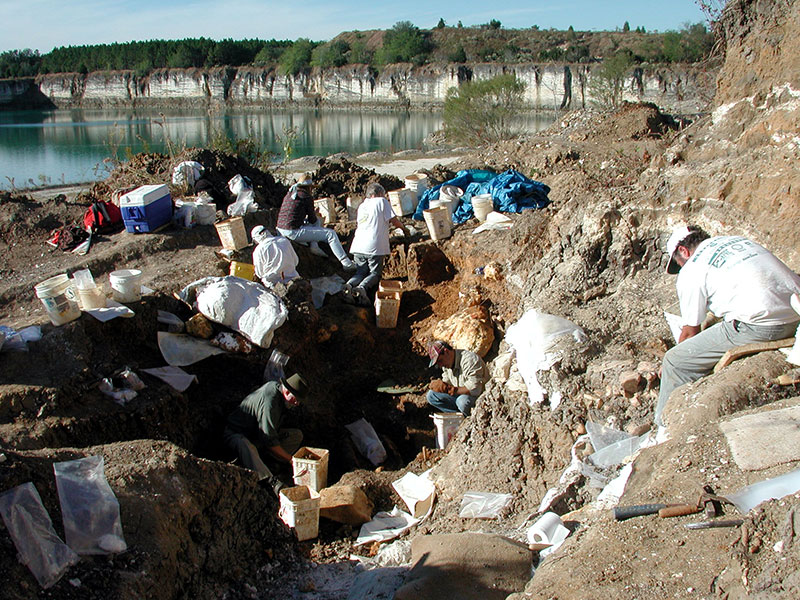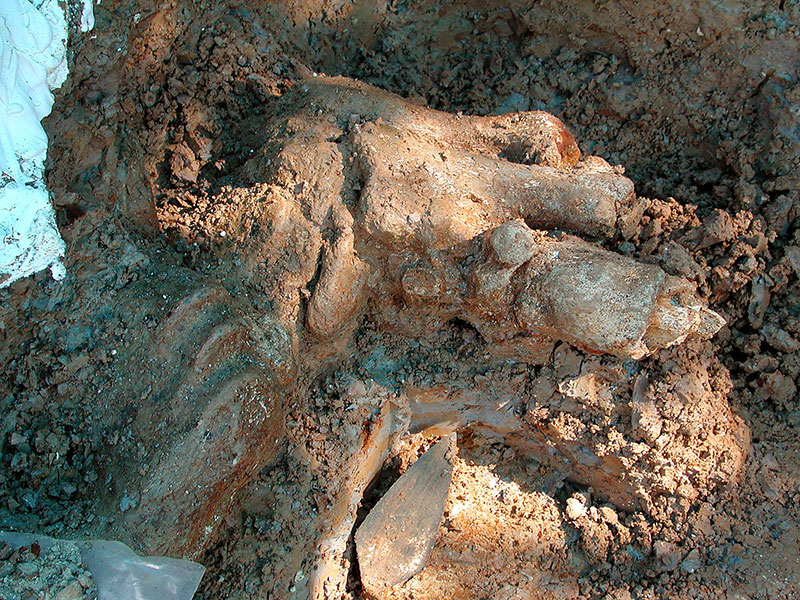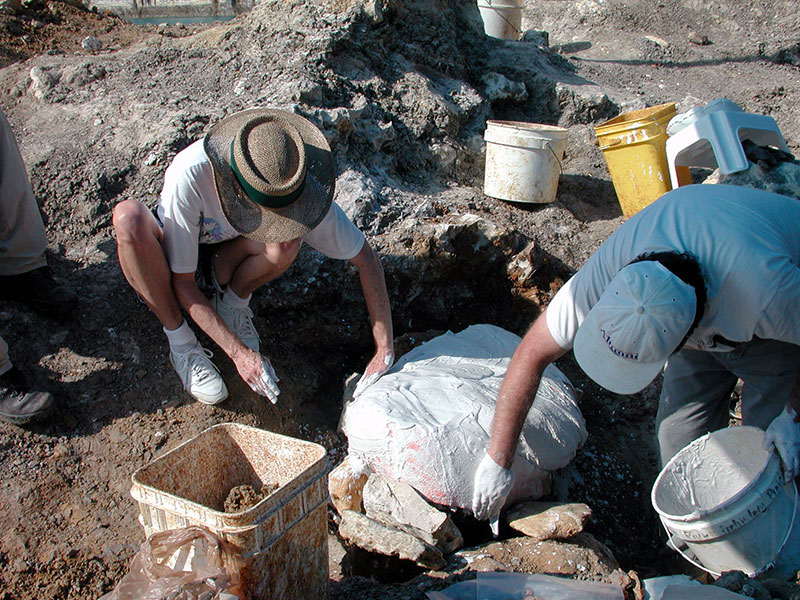Haile 7C
University of Florida Vertebrate Fossil Locality AL109
Location
In a limerock quarry about 4 miles (6.4 km) northeast of the town of Newberry, Alachua County, Florida; 29.69º N, 82.56º W.
Age
- Early Pleistocene Epoch; middle late Blancan land mammal age
- About 2.2 and 1.9 million years old (Hulbert, 2010)
Basis of Age
Biochronology and stage of evolution. A late Blancan age for Haile 7C is indicated by the presence of Tapirus lundeliusi, a species limited to the late Blancan (Hulbert, 2010). Other common species at the site, such as the giant sloth Eremotherium eomigrans and the turtle Trachemy platymarginata, are typical of the late Blancan in Florida, but persisted into the Irvingtonian. The larger size of the specimens of Holmesina floridanus compared to those from early late Blancan sites such as Haile 15A and Macasphalt Shell Pit indicates a younger age for Haile 7C (Hulbert and Morgan, 1993). An assignment to the middle late Blancan interval instead of the very late Blancan is largely based on the assumption that the nearby Haile 7C and Haile 7G sites are contemporaneous, and the age of the latter is better constrained due to the presence of age-diagnostic rodents and the sloth Paramylodon harlani.
Geology
A massive karst deposit primarily consisting of unconsolidated clay and limestone rubble. This localized deposit cannot be assigned to a formal geologic formation.

Depositional Environment
The presence of numerous articulated skeletons, an abundance of freshwater and semi-aquatic species (fish, frogs, turtles, alligators, ducks, tapirs), and the fine-grained sediment are evidence that the locality was a lake. The make-up of the non-aquatic component of the fauna suggests that the lake was surrounded by forest or woodland, and not by open prairie or grassland.
Fossils
Excavation History and Methods
The site was serendipitously discovered on March 28, 1989 by Daniel Delgado, then an undergraduate UF student, during a field trip for an introductory geology class (Anonymous, 1989). Daniel wandered away from the rest of his classmates, who were looking for Eocene invertebrate fossils in the exposed limestone and began to investigate a slumped wall of clay. There he noticed some large, unusually shaped (to him) objects weathering out of the clay that he thought might be fossils. He notified the class instructors, who recognized that they were fossil bones and took some back to campus. Later that day they brought them over to the Florida Museum of Natural History for examination by paleontology curator David Webb and collections manager Gary Morgan. Webb and Morgan recognized them as belonging to the giant ground sloth Eremotherium.
On March 30, 1989, Gary Morgan lead the first museum field crew to the newly discovered site. Mining activities in early 1989 had removed the limestone forming one side of a large, clay-filled sinkhole. Initially fairly vertical, the sidewall of the sinkhole deposit had subsequently slumped, although was still relatively steep. Tracing the trail of sloth bones up the slope, the crew discovered their origin about 8 meters above the quarry floor. At that point there were a few visible articulated Eremotherium bones lying in undisturbed sediment. For the next seven weeks Morgan and his crew removed the sediment lying directly on top of these bones, digging about two meters into the sinkhole deposit. Once a ledge had be excavated, then the museum staff dug down to expose what proved to be two mostly complete Eremotherium skeletons lying next to each other. Then several large plaster jackets were used to remove the skeletons and surrounding sediment, and taken to the museum fossil preparation lab.

During the Spring 1989 dig, while some people worked at uncovering the pair of Eremotherium skeletons, others searched and dug into the slope for other specimens. The two most commonly found items were portions of the shells (some complete) of the extinct slider Trachemys platymarginata and a very large snapping turtle. The large size and the ridges on the carapace of the snapper initially lead to their identification as alligator snapping turtles. However, once skulls and jaws were found and critically studied, they instead proved to belong to a extinct species in the same genus as the living common snapping turtle (Chelydra). Also found in the early days of the dig were several concentrations of osteoderms and limb bones of the pampathere Holmesina floridanus and a partial skull and mandibles of a porcupine. The later proved to be a new species, later described as Erethizon poyeri (Hulbert, 1997). A nearly complete, perfectly preserved skull of Holmesina floridanus was found about a meter above the two sloth skeletons. These Holmesina specimens were combined to make up the mounted skeleton on display at the Florida Museum of Natural History. The Spring 1989 session at Haile 7C ended in mid-May with the onset of North Florida’s rainy season.
Over the summer of 1989, a plaster jacket containing the articulated forelimb of the smaller of the two sloth individuals was prepped. All of the bones of the wrist and hand were preserved. Four of the digits, the first through the fourth, had claws. This was quite a surprise as previously known specimens of Eremotherium have very reduced digits one and two that lacked claws, so it has only two on each hand. This is the case for the Eremotherium found in Daytona and the skeleton on display at the Daytona Museum of Arts and Science. But those specimens were considerably younger than those from Haile 7C. While a few isolated bones of Eremotherium from Florida Blancan sites had been found before, they had not shown significant differences with the late Pleistocene species Eremotherium laurillardi. The presence of additional claws suggested that the Haile 7C specimens represented a new species of Eremotherium. For this reason, as well as the significant Holmesina and Erethizon skulls, the museum paleontology curators authorized the staff to resume excavations at Haile 7C once the rainy season came to an end.
The 1989/1990 dig began in early October. It was decided that instead of continuing to dig into the near vertical sidewall of the ancient sinkhole (with always inherent problems of slumping), excavations were started on the top of the sinkhole. Vegetation was cleared away and a meter-square grid system was established. Taphonomic data (depth, bearing, plunge) and sedimentologic information were recorded on all fossils found in situ (this was the only field season at Haile 7C in which these methods were used). From October 9, 1989 to June 1, 1990, a museum field crew usually consisting of Morgan, Art Poyer, and Richard Hulbert, plus occasional guests and volunteers, worked at Haile 7C three to four days per week, except for periods of rainy weather, a week-long break to attend the Society of Vertebrate Paleontology meeting, and a four-week-long break from mid-December to early January. In all, an area of 44 square meters was excavated, down to a depth of 2 to 2.5 meters below the surface where a layer of large limestone boulders was reached. Although no additional Eremotherium skeletons were found during the 1989/1990 field season, many isolated bones of this sloth were found. Scientifically, the most important finds were an associated skull and skeleton of a tapir (which eventually became the paratype of Tapirus lundeliusi), a series of probably associated bones of a new species of eagle, Amplibuteo concordus, and one nearly complete and several partial shells and limbs of a large, probably new species of tortoise (as yet unnamed). Many other bird bones were also recovered, including a partial humerus of a ringed kingfisher, the first record of this species from the eastern United States, and several different species of ducks (Emslie, 1998).
The next field season held at Haile 7C was relatively short, during February of 1991. In addition to numerous shells of Trachemys and Chelydra, the highlights of this dig were a nearly complete skeleton of a baby tapir and a relative complete large alligator.
Several years passed before another major field excavation occurred at Haile 7C. Gary Morgan left for New Mexico in the early 1990s, and his successor did not emphasize field work. In 1994, former UF vertebrate paleontology graduate student Dr. Steven Emslie, then on the faculty of Western State College in Colorado, received an NSF grant to study the early Pleistocene birds of Florida. With funds from the grant, Emslie paid for a backhoe to remove overburden from the site, and in December of 1994 gathered a team that included Ann Pratt and Richard Hulbert, both at the time on the faculty of Georgia Southern University, and volunteers Reed and Barbara Toomey, Steve Hutchens, and Suzan Watts. The primary goal of this dig was to find more bird fossils, but only a single specimen was found. However, it became the paratype of a new species of condor, Aizenogyps toomeyae. But other significant fossils were recovered, including an articulated complete skeleton of an adult tapir (holotype of Tapirus lundeliusi), a carapace of an as yet undescribed new species of the turtle Chrysemys, and a mandible of Eremotherium. Taking advantage of the fresh exposures created by the backhoe in December 1994, museum crews headed by graduate student Bruce Shockey and assisted once again by volunteers Steve Hutchens and Sue Watts excavated at the site for a total of 12 days from January to May 1995. In addition to the usual large haul of Trachemys and Chelydra, this effort produced a second bone of the new species of condor, parts of more tapir and sloth skeletons, and shells of Pseudemys and Apalone, two turtles which are relative rare at the site.
There were no sustained collecting efforts at Haile 7C during the period 1996 to 1999. Florida museum staff and UF graduate students went out periodically but mostly to collect specimens weathering out of the surface as the site continued to erode. The last major field season at the site occurred in October and November of 2000. Organized by Richard Hulbert, then the newly hired vertebrate paleontology collections manager at the Florida Museum of Natural History, this dig employed over 100 public volunteers. Three tapir skeletons and large portions of three Eremotherium skeletons were collected, including the most complete skull and mandibles found at the site. Casts were made of these and used for the mounted skeleton on display at the FLMNH. About 90 shells of turtles were collected; most were the common Trachemys and Chelydra, but rarer types were also found including additional shells of Pseudemys and Apalone.
The locality was scientifically announced by Hulbert et al. (1989) and the vertebrate fossils there found have been the subject of numerous publications.
All of the fossil sites in the Haile limerock mining area, including Haile 7C, are on private property and public access is not allowed.

Comments
The fossils from Haile 7C, together with the nearby Haile 7E and 7G localities, represent a 2-million-year old vertebrate community living in and around a lake (Emslie, 1998; Hulbert, 2010). The presence of abundant skeletons, sometimes fully articulated but more often partially articulated, makes these sites especially valuable from a scientific view. It was this completeness that allowed for the recognition of new species of Eremotherium and Tapirus. Three of the mounted skeletons on permanent display at the Florida Museum of Natural History were collected at Haile 7C (Eremotherium eomigrans, Holmesina floridanus, and Tapirus lundeliusi). They also represented a time interval that was previously poorly known from Florida, younger than the faunas from Macasphalt Shell Pit and the Santa Fe River (about 2.3-2.6 Ma) and older than those from Inglis 1A and Withlacoochee River 1A (about 1.6-1.75 Ma). Collectively, they are certainly one of the most important paleontological discoveries ever made in Florida. Many research projects on Haile 7C specimens have been put on hold until the fossils from Haile 7G were fully identified and cataloged. Thanks to funding from the National Science Foundation, this work will be completed in late 2015 or early 2016.
Sources
- Original Author: Julia V. Tejada-Lara
- Original Completion Date: December 13, 2012
- Editor(s) Name(s): Richard C. Hulbert Jr., Natali Valdes
- Last Updated On: February 27, 2015
This material is based upon work supported by the National Science Foundation under Grant Number CSBR 1203222, Jonathan Bloch, Principal Investigator. Any opinions, findings, and conclusions or recommendations expressed in this material are those of the author(s) and do not necessarily reflect the views of the National Science Foundation.
Copyright © Florida Museum of Natural History, University of Florida